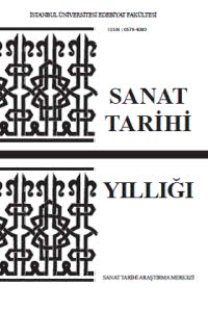Özgür Ruh, Ritmik Beden: Bizans Kültür-Sanat Hayatında Dans
Dans, çoğu kültürde olduğu gibi Bizans kültür hayatında da önemli bir tema olarak tanımlanmıştır. Konu, sanatçıların elinde can bulup imparatorluğun gayri meşru mührü haline gelen sanat yapıtlarında çokça işlenmiştir. Nitelik ve işlevsel olarak farklı gruplar yaratan eserler üzerinde yer alan tasvirler, eğlence ve neşenin imparatorluğun kültür hayatındaki yeriyle alakalı bilgilere ulaşılmasına aracılık etmiştir. Görsel olarak birtakım veriler sunan tasvirler, bahsedilen tüm bu yönleriyle adeta dile gelen bir dönem sözcüsü kimliğiyle tanınır hale gelmiştir. Bu çalışmada; yeni dini benimseyen, benimsediği din doğrultusunda hayatını düzenleyen Bizanslıların dansı nasıl algıladıkları ve tanımladıkları; bu eylemler dizisini bir şov algısı içerisinde nerede ve hangi aralıklarla tatbik ettikleri; bu tatbiklerde biçim, içerik ve yöntem olarak neleri takip ettikleri; dinin yarattığı kısmî baskıyı dansla nasıl öteledikleri; genellikle kadına ait görsel bir ifade yöntemi olarak kabul edilen dansın icra edicileri hakkındaki algıları; özgürleşen bedenin kavuştuğu rahatlığı dini ve özel yaşam içerisine dâhil edip edemedikleri ve tüm bu unsurları bir bütünlük göstererek sanat sahasında nasıl işledikleri, konuyla ilgili görseller eşliğinde anlatılmaya çalışılacaktır.
Anahtar Kelimeler:
Bizans, Kültür Tarihi, Sosyal yaşam, Din, Dans
Free Spirit, Rhythmic Body: Dance in Byzantine Culture & Art Life
Dance has been defined as a significant theme in Byzantine cultural life as in many other cultures. This was mostly subjected in works of art created by artists which then became an illegal seal of the empire. Descriptions, on works creating different groups in terms of quality and function, mediated to achieve information about the place of entertainment and joy in the cultural life of the empire. The descriptions, providing some data in visual respects, have become known through the identity of a spokesman from the period talking about all these aspects. In this study, it was tried to discuss with the visuals how Byzantines, who embraced a new religion and organised their life in line with this religion, perceived and described the dance; where and at what intervals they performed this sequence of actions in a show perception; what they followed in these performances as style, content, and method; how they postponed the partial pressure caused by religion through dance; how the persons performing the dance were generally accepted as a visual expression belonging to woman; whether they could integrate the comfort achieved by a free body into religious and private life and how they subjected all these elements in the artistic field by showing unity.
Keywords:
Byzantine, Cultural history, Social life, Religion, Dance,
___
- Bartlett, David L., Brown Taylor, Barbara, Feasting on the World Preaching the Revised Common Lectionary, Year A, Volume 2 Lent Through Eastertide, Westminster John Knox Press, USA., 2010.
- Brown, Peter Robert Lamont “Enjoying the Saints in Late Antiquity”, Early Medieval Europe Journal, Vol. 9, USA., 2000, s. 1-24.
- Burkert, Walter, Greek Religion, Harvard University Press, USA., 1985. Choniates, Nicetas, O City of Byzantium: Annals of Niketas Choniatēs, Trans. by. Harry J. Magoulıas, Wayne State University Press, Michigan, 1984.
- Clement of Alexandria, The Instructor (Paedagogus), Fathers of the Second Century: Hermes, Tatian, Athenagoras, Theophilus, and Clement of Alexandria (Entire), Trans. by. William Wilson Vol. II, Christian Literature Publishing Company, NewYork, 1885.
- Danforth, Loring M. “The Rôle of Dance in the Ritual Therapy of the Anastenaria”, Byzantine and Modern Greek Studies, Cambridge University Press, 1979, s. 141-163.
- Danforth, Loring M., “Power through Submission in the Anastenaria”, Journal of Modern Greek Studies, Vol. 1, No. 1, Johns Hopkins University Press, USA., 1983, s. 203-223.
- ISSN: 0579-4080
- Yayın Aralığı: Yıllık
- Başlangıç: 1964
- Yayıncı: İstanbul Üniversitesi
Sayıdaki Diğer Makaleler
19. Yüzyıl İngiltere’sinde Shalott Lady’si Betimleri
Özgür Ruh, Ritmik Beden: Bizans Kültür-Sanat Hayatında Dans
Türk Mimarisinin Günümüze Kadar Geldiği Yerleşim: Tarhala
Arşiv Belgelerine Göre Hasköy’ün Günümüze Ulaşamayan Ermeni Eğitim Yapıları
Erken Bizans Döneminde Doğu Sınırında Kentleşme Politikası: Martyropolis
Batı Resminde Kâhin Kadının Temsili Olarak Sibyl Betimleri
Kosova’daki İki Rifai Tekkesi’nden İmgeler
V. Belgin DEMİRSAR ARLI, Şennur KAYA, Gülsu ŞİMŞEK FRANCİ
Malatya Arkeoloji ve Etnoğrafya Müzelerinde Bulunan Türk- İslam Dönemi Mezar Taşları
